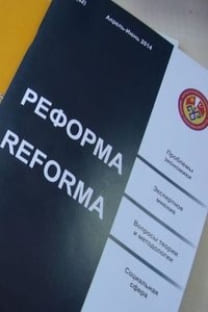HYSTERESIS IN UNEMPLOYMENT: KYRGYZSTAN CASE
Hysteresis in economics occurs as a result of economic crises. The mechanism called unemployment hysteria refers to the situation that the increasing unemployment rate that occurred during the economic shock does not return to its previous state (average even) after the effect of the economic shock disappears. In 1986, O. Blanchard and L. Summers tried to explain unemployment hysteria with the help of the "Insiders and Outsiders" model.
The purpose of this research is to test the validity of the unemployment hysteria hypothesis for Kyrgyzstan. For analysis quarterly data of unemployment rates for the period 1999-2017 were used. The validity of the hypothesis was tested with the help of the Zivot Andrews structural break unit root test and the Long Memory Unit Root Test. The results obtained provide evidence that the hysteria hypothesis is valid for unemployment rates for the period 1999-2017 for Kyrgyzstan.
HYSTERESIS IN UNEMPLOYMENT: KYRGYZSTAN CASE
Hysteresis in economics occurs as a result of economic crises. The mechanism called unemployment hysteria refers to the situation that the increasing unemployment rate that occurred during the economic shock does not return to its previous state (average even) after the effect of the economic shock disappears. In 1986, O. Blanchard and L. Summers tried to explain unemployment hysteria with the help of the "Insiders and Outsiders" model.
The purpose of this research is to test the validity of the unemployment hysteria hypothesis for Kyrgyzstan. For analysis quarterly data of unemployment rates for the period 1999-2017 were used. The validity of the hypothesis was tested with the help of the Zivot Andrews structural break unit root test and the Long Memory Unit Root Test. The results obtained provide evidence that the hysteria hypothesis is valid for unemployment rates for the period 1999-2017 for Kyrgyzstan.
___
- Кашепов, А.В., Сулакшин, С.С., Малчинов, А.С. Рынок труда: проблемы и пути решения. – М.: Научный эксперт, 2008.
- Кучма, К., Кучма, О., Горбунова, О. Безработица: виды, причины и пути решения // Социально экономические явления и процессы. – 2015. – No 7. – С. 7-83.
- Кутукеев, Б.С. Безработица в Кыргызстане. Проблемы и пути их решений. – Режим доступа: http://arch.kyrlibnet.kg/uploads/NSU_KUTUKEEV1.pdf
- Кыргызстан: экономический рост, занятость и сокращение бедности. – Бишкек: МОТ, 2008.
- Марыганова, Е. А., Шарипо, С.А. Макроэкономика. Экспресс курс: учебное пособие. – М.: КНОРУС, 2010. – С. 302.
- Элмуратов, Ш.З., Балтабаев, А.Г. Безработица в Кыргызстане и в мире (анализ основного направления) // Известия вузов Кыргызстана. – Бишкек, 2016. – No 10. – С. 181-183. 7.
- Ahmet Tayfur Akcan. Türk Cumhuriyetlerinde İşsizlik Histerisi: Panel Veri Analizi Turkish Studies // Economics, Finance, Politics. – 2019. –Volume 14. Issue 3. – S. 623-637.
- Banerjee, A. and Urga, G. Modeling structural breaks, long memory and stock market volatility: An overview // Journal of Econometrics. – 2005. – No 129. – S. 1-34.
- David Gray. Persistent Regional Unemployment Differentials Revisited // Regional Studies. – 2004. – No 38:2. – P.167-176. 10. Eric Zivot and Donald W. K. Andrews // Journal of Business & Economic Statistics. – 1992. – Vol. 10. No. 3. – P.251-270.
- Evrim Turgutlu Fisher (2004). Fisher Hipotezinin Tutarlılığının Testi: Parçalı Durağanlık ve Parçalı Koentegrasyon Analizi // D.E.Ü.İ.İ.B.F. – Dergisi Cilt:19. Sayı:2. – S. 55-74.
- Fumitaka Furuoka. Unemployment hysteresis in Central Asia MPRA. Paper No. 60323, 2014.
- Hüseyin Çelik (). İşsizlik Histerisi Geçerliliğini Türkiye ve Komşu Ülkeleri İçin İncelenmes. // ASSAM Uluslararası Hakemli Dergi. – 2019. – Cilt: 6. Sayı: 15. – S. 38-48.
- Knut Roed. Unemployment Hysteresis - Macro Evidence from 16 OECD Countries Empirical Economics 21, 1996. – P. 589-600.
- Giorgio Brunello. Hysteresis and “The Japanese unemployment problem”: Preliminary investigation. Oxford Economic Papers 42, 1990. – P. 483-500.
- León-Ledesma, Miguel A. Unemployment Hysteresis in the US and the EU: a Panel Data Approach, Department of Economics Discussion Paper. – University of Kent, Department of Economics, Canterbury, 2000. – No. 0006.
- Luis A. Gil-Alana. Modelling the Persistence of Unemployment in Canada // International Review of Applied Economics. – 2002. – No 16:4. – Р. 465-477.
- Mikhaila O., Eberwein C. J. and Handac J. Estimating persistence in Canadian unemployment: evidence from a Bayesian ARFIMA // Applied Economics. – 2006. – No 38. – P. 1809-1819. 19.
- Selahaddin Güliş ve Ebru Çağlayan (2000). Ekonometri temel kavramlar. – İstanbul dergi yayınları, 2000. – S. 695.
- Tsangyao Chang, Kuei-Chiu Lee, Chien-Chung Nieh & Ching-Chun Wei (2005). An empirical note on testing hysteresis in unemployment for ten European countries: panel SURADF approach // Applied Economics Letters, 2005. – P. 881-886.
- ISSN: 1694-5158
- Yayın Aralığı: Yılda 2 Sayı
- Başlangıç: 1999
- Yayıncı: Kırgızistan Türkiye Manas Üniversitesi
Sayıdaki Diğer Makaleler
BLOCKCHAIN TEKNOLOJİSİNİN ÇEVRESEL ETKİLERİNİN DEĞERLENDİRİLMESİ
THE IMPACT OF THE SECURİTİES MARKET ON ECONOMİC GROWTH. CAUSALİTY ANALYSİS
IMPACT OF THE COVID-19 PANDEMIC ON THE SOCIO-ECONOMIC DEVELOPMENT OF KYRGYZSTAN
Ayganysh SAYAKBAEVA, Nelly AKYLBEKOVA, Taalaibek TEMIRLAN
KIRGIZİSTAN DIŞ POLİTİKASINDA TÜRKİYE İLE İLİŞKİLERİNE GENEL BAKIŞ
COVID-19 PANDEMİSİNİN KIRGIZİSTAN’DAKİ HANEHALKINA EKONOMİK ETKİLERİ
Junus GANİEV, Razia ABDIEVA, Damira BAIGONUSHOVA
